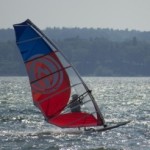Home Page › Discussion Forum › General Windsports Discussion › Sail Chi – The Most Important Skill in Windsurfing
- This topic has 0 replies, 1 voice, and was last updated 4 years, 6 months ago by
 Geoff.
Geoff.
-
AuthorPosts
-
-
October 15, 2019 at 8:30 pm #7620
 GeoffParticipant
GeoffParticipantSail Chi
I had the pleasure, quite some years ago (I think 2002 and 2003), to take some Andy Brandt freestyle clinics in Bonaire. What I was exposed to in the first year took me a year to learn how to do. By the second clinic, Andy had opened my mind to the secrets of how to do moves that generally evoke the reaction “How did he do that”?
In recent years I’ve not had much TOW, so it’s probably useful for me to review my notes from Andy’s clinic, to buff up my skills. Combined with Brad Duffy’s tips on how to tune your kit, these skills are priceless. And with all of this to learn and master, why would I ever want a kite (or even a foil)? That said, these skills would be extremely useful when on a foil.
The secret of secrets in windsurfing (even more than learning how to balance up your kit) is learning to luff the sail. With your feet on the centerline and easy flexing ankles, it’s AMAZING how much wind you can be out in and just control the sail with 2 fingers. Even in a full gale. Chaos all around you, but on the board you’re in a calm peace. All because you know how to make the sail powerful when you want it to be powerful, and have no power when you want it to be easy.
The reason this is valuable is that you’re going to find yourself in all kinds of positions, overpowered, underpowered, planning, schlogging, maneuvering, etc., and the key to not falling is to keep over the centerline and depowering the sail so that it’s not pulling you off balance. No matter what position the sail and you are in (clew-first, mast-first, front to back, back to back, back to front, front to front) you want to be able to control the power so that the sail pulls only when you want it to pull. And then when you want the sail to rotate, so that you can change positions with the sail, you can get out of the way when it swings to where you are standing.
Riding a sailboard is like a dance, the sail is your partner. Except when you’re sheeted-in and trying to go fast, the sail has no power in it at all because of how you are handling it to keep it luffing in the position you want it to be in. Mastering this skill is how the modern freestyle aerials are made to look so effortless. I saw that Andy took these skills to Bonaire, that the “Bonaire Kids” took his lessons to heart, mastered them, and freestyle hasn’t been the same since.
Good luck with these drills. I’m convinced that, despite how lame they look on the beach, these drills more than anything else will transform your sailing. If what you do right now is muscle the sail to make it do what you want it to do…well, you’ve got a lot to master.
Andy gave us 5 main drills, which he called boom boxing, for the purpose of developing sail control. I liked the name Sail Chi better. I have clarified / modified / added some for a total of 10 drills. He did not explicitly state that these drills (at least drills 1-7) should be done on the water, but if you look at his moves on the water, he uses these skills extensively. Especially so in a clew-first mode. I am thus convinced that when these skills have been mastered on dry land, you should do them on the water.
Be sure that there is nothing within the arc of the sail’s peak when you do these drills. Most of these sail positions are inherently unstable and can fall rapidly and with considerable force. Allow yourself a wide swath when practicing these drills.
These drills roughly go from easiest to hardest. My estimation of the value of the skill, in terms of day-to-day usefulness, is marked by asterisks (* ** *** **** *****).
Sail Chi #1 – Luffing from the Mast ***
Position the drag board close-hauled, bearing about 10 or 2 o’clock
Stand astraddle the mast base, in the back wind position (aka front to back)
Place the front hand on the mast
Place the back hand at the balance point
Sheet in gently with the back hand and control the sail to keep it flyingThis skill is key for sailing front-to-back (i.e, on the backside of the sail, facing upwind)
Sail Chi #2 – Luffing from in Front of the Balance Point ***
Position the drag board close-hauled, bearing about 10 or 2 o’clock
Stand astraddle the mast base, in the back wind position (aka front to back)
Place the front hand at the balance point
Touch the boom with the back hand to sheet in
Sheet in gently with the back hand and control the sail to keep it flyingThis skill is key for sailing front-to-back, but with more power than in Sail Chi #1
Sail Chi #3 – Boomerang Drill **
Position the drag board close-hauled, bearing about 10 or 2 o’clock
Stand behind the mast base, in the back wind position (aka front to back)
Using one hand on the boom at a time, first front then back, push the sail down and into the wind
Let it fly back up to you, pushing it back down with the appropriate hand position
Use a light touch, open palms, no gripping the boomThis skill is key for learning how to save the sail from dropping into the water
Sail Chi #4 – Luffing using the Fabric **
Position the drag board close-hauled, bearing about 10 or 2 o’clock
Stand astraddle the mast base, in the back wind position (aka front to back)
Using one hand on the sail at a time, push the sail down and into the wind
Let it fly back up to you, pushing it back down with the appropriate hand / hand position
Use a light touch, open palms, no gripping the boom or sail
Touch the sail at extreme distances from the balance point, and see how long you can keep it flyingThis skill is key for learning how to use any part of the sail you can touch (with any part of your body)
Sail Chi #5 – Luffing Back-to-Back **
Position the drag board close-hauled, bearing about 10 or 2 o’clock
Stand astraddle the mast base, in the back wind position, but back to back (your back to the sail)
Your butt should be against the sail in front of the balance point
Use your body to resist the sail as a “mast hand” and your back leg’s calf to sheet in
Also, twisting back and forth at the hips will work to sheet and unsheet the sailThis skill is key for sailing back-to-back, a position from which you’ll need to learn how to escape. Also, this position is key for learning back wind pivot gybes from the back-to-back position.
Sail Chi #6 – Luffing One-Handed from Behind the Balance Point *****
If you learn one skill, learn this one
Position the drag board close-hauled, bearing about 10 or 2 o’clock
Stand behind the mast base, in the normal sailing position
Move your back hand to as far behind the balance point as you can reach
Let go with your mast hand
Keep the sail luffed, while staying on the boardFar and away the most useful sail-handling skill, developing a feel for the sail that is far superior to anything else you will learn.
Sail Chi #7 – Luffing One-Handed from the Clew (extreme version of drill #6) *
Position the drag board on a beam reach, bearing at 9 or 3 o’clock
Stand downwind of the board, on the ground
Luff the sail, using both hands
Let go with your mast hand and move your back hand to the very end of the clew
Keep the sail luffed by moving the clew back and forth to counter the sail’s tendency to fall overFun on the beach when there’s hardly any wind, not as useful on the water
Sail Chi #8 – Luffing Clew-First, One-Handed, in Front of the Balance Point ****
If you learn two skills, make this the second one
Position the drag board close-hauled, bearing about 10 or 2 o’clock
Stand behind the mast base, in the normal sailing position
Position the sail in a clew-first position and luff the sail
Move your clew hand to as far from the balance point as you can control
Let go with your mast hand
Keep the sail luffed, while staying on the boardThis skill is key for sailing in the clew-first position, an enormously valuable skill. There are many many times when the easiest choice is holding a clew-first position, even on a plane, and this is how to learn it
Sail Chi #9 – Luffing Clew-First, One-Handed, from the Mast
Position the drag board on a beam reach, bearing at 9 or 3 o’clock
Stand downwind of the board, on the ground
Position the sail with the clew to windward and the mast aligned with the board
Stand on the lee side of the mast, and rock the boom to raise the clew into the wind
Keep the sail luffed by moving the mast back and forth to counter the sail’s tendency to fall overThis is fun on the beach, but has less value on the water. A more useful variant follows as #10. sailing front-to-back (i.e, on the backside of the sail, facing upwind)
Sail Chi #10 – Suicide Drill (more useful variant of drill #9)
Position the drag board on a beam reach, bearing at 9 or 3 o’clock
Stand downwind of the board, on the ground
Position the sail with the clew to windward and the mast aligned with the board
Stand on the lee side of the mast, and rock the boom to raise the clew into the wind
Move the mast hand to the boom, close to the mast (this is more useful on the water than the previous drill, and is used in suicide tack exits)
Keep the sail luffed by moving the mast back and forth to counter the sail’s tendency to fall overThis skill is great for doing an “opposite direction” escape from the clew-first position – the kind of move where the crowd thinks “What…, how did he…, that one looked different, but, like,…what was that”?
Modern freestyle sailing is nothing more than <span style=”text-decoration: underline;”>combinations of these skills, strung together and executed in the air (and then after landing on the water), after a chop hop</span>. Yeah, right, he says “nothing more“…
I’m can’t say that Andy Brandt opened the door to modern freestyle, but only because I can’t be sure that others didn’t get to these ideas at the same time. But I don’t think anyone got there ahead of him. I can’t recommend Andy’s clinics highly enough.
https://www.abkboardsports.com/
-
This topic was modified 4 years, 6 months ago by
 Geoff.
Geoff.
-
This topic was modified 4 years, 6 months ago by
-
-
AuthorPosts
- You must be logged in to reply to this topic.
